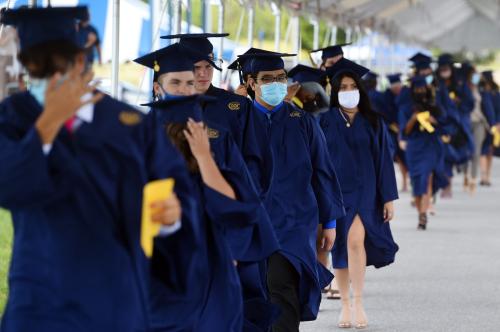If you want more content like this, subscribe to our newsletter.
This week in Class Notes:
- An unconditional free college program targeted to low-income students substantially increases college enrollment rates.
- Childcare time of higher educated mothers is more productive than that of low-educated mothers and that of non-parental care.
- A U.S. child allowance could generate social returns up to 10 times the cost, and save taxpayers money in the long run.
- This week’s top chart shows that differences in family planning access alone can account for 20% of the racial gap in upward mobility
- Steven Greenhouse argues that support from national unions could fuel the growth of an emerging worker-to-worker organizing model.
- Check out our new piece about how the 568 Group Colleges use their price-setting power to offer more aid to low-income students, not less.
- For your calendar: Events on immigration and the future of caregiving, public economics, LGBTQ+ intergenerational mobility, and the economics of education
An unconditional free college program targeted to low-income students substantially increases college enrollment rates
Scholarships to cover the cost of college can improve college enrollment and completion rates among lower-income students. But the details of the scholarship offer matter a great deal, according to a new study by Elizabeth Burland and her colleagues. They compare the effects of two offers made to low-income, high-achieving high school students in Michigan (i.e. eligible for free school meals, and with an SAT of 1100 or more and a GPA of at least a B). The first offer was the HAIL Scholarship, unconditionally guaranteeing free four-year tuition and fees at the University of Michigan. The second was the Go Blue Encouragement that conditionally offered aid for up to four years based on a financial aid application each year. In both cases, the offer was accompanied by a personalized letter from the college President. Students were randomly assigned to one of the two offers or to a control group. The unconditional offer raised enrolment rates by 9 percentage points (from 17% to 26%), while the effect of the unconditional offer was below one percentage point, and statistically insignificant. The main reason for the gap is that application rates were lower among Go Blue students, likely because many received an aid offer than fell short of “free tuition.” These results suggest that first, certainty matters – an offer of free college must be unconditional to work, but second, that this goal can be achieved by targeting the offer of free college on this group.
Childcare time of higher educated mothers is more productive than that of low-educated mothers and that of non-parental care
Infant children who spend more time with their mothers see faster development, with the biggest gains see for well-educated mothers. Using data from the Panel Study of Income Dynamics, Ylenia Brilli finds that a 10% increase in a mother’s childcare time for a one year old child – around 2.5 hours per week – increases cognitive ability by 18% for the child of a highly-educated mother (more than 12 years of completed schooling) and 10% for those with a less-educated mother. Time in childcare settings also increases cognitive development, but more in formal (7% increase) than informal settings (5%). Brilli’s models show that highly-educated mothers face a sharper trade off in the decision between paid work and caring for very young children, because as she writes, “the alternative forms of care available –either formal or informal– cannot fully compensate for the reduction in a child’s ability induced by their lower child-care time”. This may help to explain why educated mothers are more likely to exit the labor market than their less-educated peers, Brilli suggests.
A U.S. child allowance would generate social returns up to 10 times greater than the costs
There’s growing interest in a permanent child allowance, but heated debate about the costs and benefits. So what’s the evidence? Irwin Garfinkel and his colleagues carried out a meta-analysis of 21 studies analyzing the impact of cash transfers on long-term outcomes. Overall, they find that for a single-parent, low-income family, a $1,000 annual child allowance would generate social benefits more than 5 times greater the initial transfer. Extending these calculations to reflect the 2021 American Rescue Plan expansion of the Child Tax Credit, they estimate that a child allowance of $3,600 per child ages 0-5 and $3,000 per child ages 6-17 would cost $97 billion a year but deliver benefits worth $982 billion, resulting in net annual savings to taxpayers of $135 billion over the long term. The largest benefits are improvements in children’s health and longevity ($424 billion), higher future earnings ($270 billion), and lower crime rates ($208 billion).
Top chart: Differences in family planning access alone can account for 20% of the racial gap in upward mobility
Most intergenerational mobility models do not account for unintended fertility, which is disproportionately common among Black Americans. When we do account for it, this reduces intergenerational mobility. This chart shows that if policies could equalize family planning costs across races, this would eliminate 20% of the Black-White gap in absolute upward mobility.
 Source: National Bureau of Economic Research
Source: National Bureau of Economic Research
Choice opinion: Support from national unions would certainly help a worker-to-worker organizing model expand
“If union leaders are sincere in their talk about reversing the labor movement’s decades-long decline, they need to encourage the unionization bug to jump from Starbucks and Amazon to McDonald’s, Chipotle, Burger King, Walmart, Target, and elsewhere. There’s far too much inertia among labor officialdom—the folks who have tens of millions of dollars in resources—and not enough vision on how to optimize this moment,” writes Steven Greenhouse.
Self promotion: The 568 Group Colleges actually use their price-setting power to charge more to higher-income students and use the additional funds to offer greater aid to low-income students
The 568 Group is a group of elite colleges recently charged with illegal collusion to limit financial aid to students by inflating the price of attendance. Our colleague Philip Levine argues that this kind of antitrust approach distracts from the larger goal of providing greater access to college for lower-income students. “Colleges and universities could use their price-setting ability to increase their profits, but, crucially, they are nonprofit institutions with an educational mission,” he writes. “In practice, they use their price-setting power to charge higher prices to higher-income students and use the additional funds to offer greater financial aid to lower-income students, charging them less.”
For your calendar: Events related to immigration and the future of caregiving, public economics, LGBTQ+ intergenerational mobility, and the economics of education
Who will care for aging baby boomers? Immigrants.
Brookings Institution
Tuesday, April 19, 2022 11:00 AM EST – 12:15 PM EST
Public Economics Program Meeting, Spring 2022
NBER
April 21-22, 2022
Intergenerational Mobility of LGBTQ+ Individuals
American Economic Association
Tuesday, April 26, 2022 12:00 PM EST – 1:00 PM EST
Economics of Education Program Meeting, Spring 2022
NBER
April 28-29, 2022
The Brookings Institution is committed to quality, independence, and impact.
We are supported by a diverse array of funders. In line with our values and policies, each Brookings publication represents the sole views of its author(s).








Commentary
Class Notes: Unconditional free college tuition, productivity of maternal childcare, and more
April 19, 2022